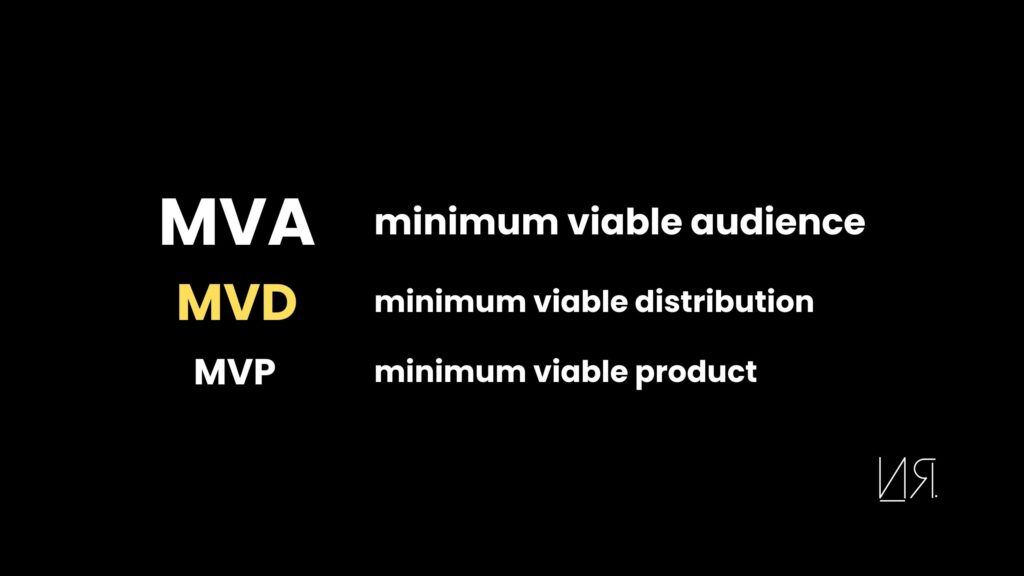“Building isn’t the problem, knowing the right thing to build is.”
That’s a quote from a founder I spoke to recently. He elaborated: “we have challenges of getting the right users. If we can get them, then we can get feedback to build the right solution for them.”
Most businesses focus on their product, latest features, shiny new UX. They unfortunately create a “solution bubble” for themselves. In reality, what they need is to get their solutions in front of the right audience.
I’ve fallen for the same trap before. I spent months tinkering with my app in my first business until I put my head up on release day, and realized I didn’t build the skill to drive people to my solution.
I’ve been building that skill ever since.
Because distribution is more important than your product.
No distro, no cash:
Distribution is an afterthought for a lot of business builders.
Here’s the real reason: People like to geek out on projects and hate social rejection.
The combination of the two is a numbing drug of constantly being in your own bubble.
It’s innate in us. Humans don’t want to feel ostracized.
So we stay in the comfort of “build, build, build,” and ignore the challenge of getting used to rejection required to get you to the right people.
That’s why you need three things:
- minimum viable product (MVP)
- minimum viable audience (MVA)
- minimum viable distribution plan (MVDP)
Most people only focus on 1.
Audiences, markets, and attention keep shifting. You have to fly a tight iterative loop of product development and market validation.
Designing a minimum viable distribution plan gets your MVP to your MVA.
This is how you refine product-market fit.
Choose channels not just for reach, but for the quality of conversations they enable.
Trusted advisors aren’t everywhere. They’re in the right rooms.
5 Steps To Design Your Minimum Viable Distribution Plan
In 2021, I got into NFTs and crypto art projects.
I attended three yearly conferences, and interacted with the community on Twitter/X. I met a lot of entrepreneurs and artists in the space. My X feed was filled with flashing posts of drugged-out cats with lasers shooting out of their eyes, and I loved it.
I started my own crypto project to crowdfund my 4th book. It was successful.
I posted about my book crypto project on LinkedIn. I got no love.
In my mind I was like “Hey guys, this… entrepreneurship on the blockchain. Business and innovation.” Yada Yada Yada.
Silence! The LinkedIn wanderers gave me the side eye.
A few months later I began posting about my writing journey and business leadership on the white and blue app. The reactions flooded in.
Same thing, different language.
Every channel has its audience, culture, and language.
Once you understand that different channels have their unique culture, you’ll know how to leverage this to reach your audience where they hang out.
You’ll have a targeted approach that keeps you focused enough to gain traction for the business, even with limited resources.
Here’s how to match the right message to the right channel for maximum impact.
1. The are only two main channels:
Real life and digital life.
Don’t overcomplicate things. These are the two main channels to focus on. Video calls are sort of a hybrid of these two but as stated earlier, nothing beats real high-value conversations with humans.
Remember: the goal of your digital life is to drive real-life conversations.
2. Real-life presence:
This is the highest-leverage activity you can do.
Be literally in front of the people you want to talk to.
You can build trust a lot faster in-person. You pick up on body language without internet glitches. If you were to choose one activity to do today, find the top three conferences for your business and go to them.
In my first business, I was amazed that my clients – executives at global enterprises – would fly across the ocean just to have a 45-minute meeting. I thought this was just a unique vetting style of emerging markets. But it is now becoming more important across the globe, when people don’t know if they are interacting with a properly fine-tuned AI agent online.
But not all in-person events are built equally.
The level of intimacy ranges from one-on-ones to private events to conferences.
Here are a few tips I’ve learned:
- At a conference, try to be a speaker on a stage. It’s better than handing out a thousand business cards.
- Go to private events away from the conference.
- Contact speakers ahead of the conference to request a one-on-one.
- Make sure you have a follow up plan so it’s easy to stay in touch.
Real life channels are the best to build deep trust.
The only problem with them is that you are only ONE person. It doesn’t scale. That’s where the digital channel comes in.
3. The Digital-life scale
Talk online to get offline.
Digital scales what real life doesn’t.
It’s not a replacement but a funnel to the real-life channel. To choose the highest leverage for your digital strategy, look at output and effort.
What’s the most output you can get from the minimal use of your resources?
The two levers here are:
- picking the right platform (output), and
- choosing the most repeatable format (inputs).
3. The right platform:
LinkedIn, Reddit, X, Facebook, Snapchat, TikTok, Youtube, Discord.
Where should I post?
I hear this all the time. Ideally, you should be everywhere, practically you should start with one focus. Start with the channel that most likely has your audience. Then go understand the culture of the platform.
For instance, if you are:
- focusing on a B2B business, your best bet is LinkedIn.
- into Blockchain, X for education, Discord for community.
- B2C and lifestyle business, TikTok, Instagram.
- connect with fellow clear thinkers, substack might be the way to go.
- buying old businesses to flip, then you might want to be on Facebook.
When I started, I chose LinkedIn because my business targeted executives at tech and engineering companies.
Again, you might be tempted to be in all places at once.
Start with one. Focus on getting good at it.
I have been posting consistently on LinkedIn since 2019 and I am still learning everyday, because the culture and algorithm on each platform changes often.
If you have the resources, then repurpose on the other platforms.
Never forget, the goal is not to stay on these channels, it’s to drive real-life conservations.
4. What’s your format
There are three formats online: written, audio, video.
Choose the one that you and your team can get to consistently. For instance, as a one-man band, I choose writing because that’s my most practiced form of communication. If you are more comfortable speaking, choose an audio format like a podcast.
Bigger teams can do a combination of all three formats. It all depends on your resources.
Choose a format that you can stick to on a weekly cadence and plan to stick to it for a year.
5. Build a partnership ecosystem:
The fastest way to grow your audience is by borrowing.
No, not financial capital in the form of money from a bank. I’m talking about social capital in the form of borrowing other people’s audiences. Partner and collaborate to increase the impact of your distribution effort.
There are two main partnerships to prioritize:
- Similar sized businesses in your industry or companies that value what you value.
- What they need: Support
- Larger businesses with audiences that already have the audience you are looking for.
- What they need: Value-add
You know the type of support you need, give it to others on the same path. Grow together.
On the other side of the spectrum, guess what these businesses that have a bigger audience want? They want content to add value to their audiences.
Here’s how you can leverage those opportunities:
- Find gaps in their content and pitch to create it with them (e.g. a guest post, a niche course with a course creator, a unique episode with a podcast host).
- On social, be the first to reply to their posts with something insightful. This boosts their engagement and also puts you in front of their audience.
Go create a list of 50 partners (25 similar, 25 bigger) in your ecosystem in real and digital life.
Start engaging.
6. 12-month execution:
By the end of this you should have a minimum distribution plan as follows:
- 3 top events for the year
- 1 focused platform
- 1 dedicated media format
- A list of partners to collaborate with in your ecosystem.
Now all you have to do is follow the plan and stick to it.
Yours truly,
Nifemi



